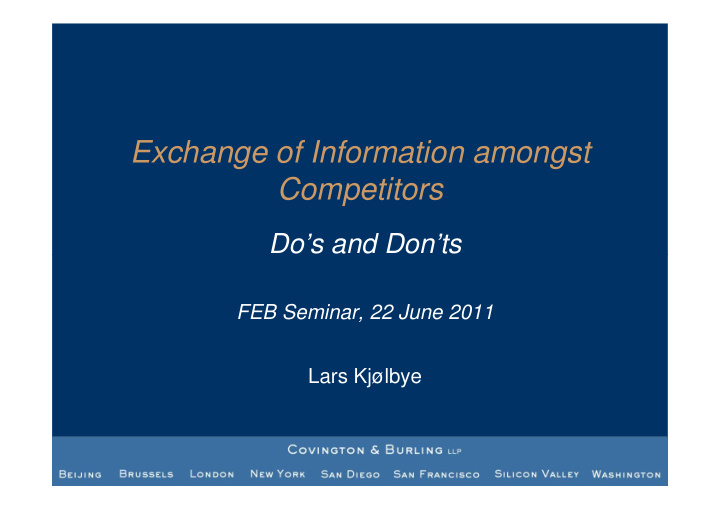



Exchange of Information amongst Competitors Do’s and Don’ts Do’s and Don’ts FEB Seminar, 22 June 2011 Lars Kjølbye
Information exchange: exposure • New chapter in Commission Guidelines on horizontal cooperation agreements • New focus of competition authorities • Relevant in many contexts – Cooperation agreements – Trade associations – Ad hoc meetings with competitors at all levels 2
Information exchanges and Article 101 TFEU • Depending on the circumstances information exchange agreements may – be innocuous or efficiency enhancing – have restrictive effects – have a restrictive object and be treated as a cartel 3
Information exchange and uncertainty • Information exchange may affect competition by reducing market uncertainty • Two relevant types of uncertainty: – Uncertainty regarding the functioning of the market – Uncertainty regarding the market conduct of competitors 4
Exchange must result from collusion • Article 101 TFEU requires collusion, i.e. a concurrence of wills or meeting of minds of at least two parties. Unilateral conduct (i.e. non-collusive behaviour) is only subject to Article 102 TFEU behaviour) is only subject to Article 102 TFEU – Article 101 applies if competitors reveal to each other the market conduct which they intend to adopt ( explicit collusion ) – Competitors may adapt their own unilateral conduct to the unilateral conduct of others ( tacit collusion ) – Article 101(1) applies if explicit collusion facilitates tacit collusion e.g. by artificially increasing market transparency 5
Key distinctions • Restrictions by object – Enchanges about intended future prices and output ( T-mobile Netherlands) • Restrictions by effect – Exchanges of current or past information in concentrated markets ( UK Tractor ) ( UK Tractor ) • Ancillary exchanges – Exchanges that are necessary for a commercial cooperation to function properly ( Grand Alliance) • Unrelated exchanges – Exchanges that are unrelated to or non-ancillary to a commercial cooperation (compare E.ON/GDF) • Stand alone exchanges – Organised exchange e.g. in context of trade association (UK Tractor, European Wastepaper Information Service (EWIS)) – Ad hoc exchanges between employees 6
Nature of the information • Aggregated vs individualised data • Private vs genuinely public data • Private vs public exchange • Private vs public exchange • Age of date • Frequency of exchange 7
Information exchange: don’ts • Don’t provide commercially sensitive information to competitors (outside context of cooperation arrangement) • Don’t participate in meetings in which such information is exchanged • Don’t agree to make commercially sensitive information public • Don’t pass on sensitive information to staff not involved in a cooperation arrangement • Don’t exchange individualised information in trade association meetings 8
Information exchange: do’s • Exchange information with non-competitors • Collect market intelligence from suppliers, distributors and customers • Exchange statistical data on market functioning through trade associations – Have effective safeguards against disaggregation • Exchange genuinely public information but be aware of narrow scope (French petrol stations) 9
Thank you for your attention Lars Kjølbye Covington & Burling LLP Avenue des Arts 44 Avenue des Arts 44 B-1040 Brussels lkjolbye@cov.com 10
Recommend
More recommend